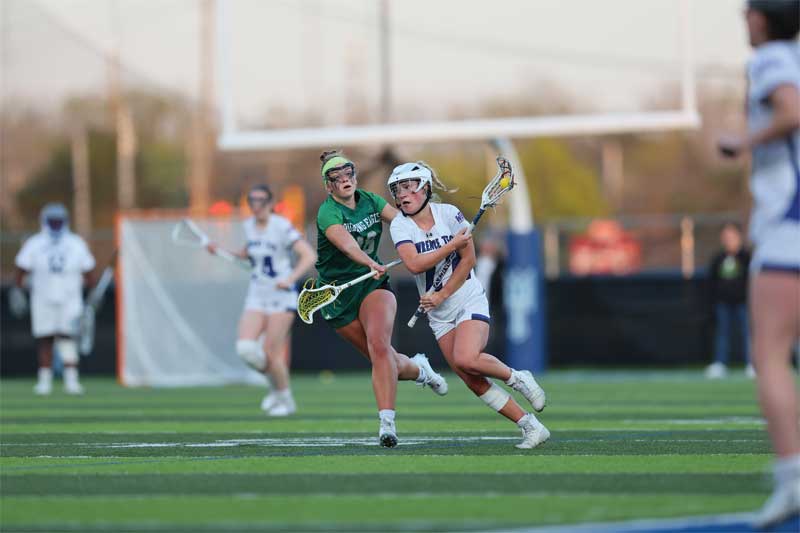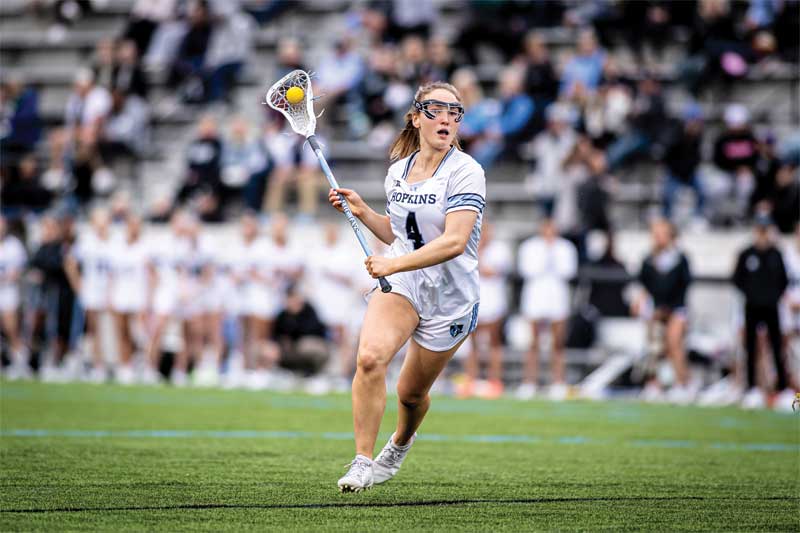
Lacrosse continues to grow in popularity across the United States, with new rules implemented to keep the sport safe while speeding the game’s pace.
More than two million athletes play the centuries-old sport in the United States, according to the Physical Activity Council and the Sports & Fitness Industry Association. Lacrosse continues to net new players as the fastest-growing sport at both college and high school levels.
In the past 20 years, the number of NCAA men’s lacrosse teams—across all divisions—has almost doubled, from 208 in 2000-01 to 395 teams in 2022-23. In women’s lacrosse, the number of teams more than doubled, jumping from 238 in 2000-01 to 522 in 2022-23.
During the 2022-23 school year, 16,030 male athletes competed in men’s lacrosse across NCAA Division I, II, and III. In women’s lacrosse, 13,481 athletes competed in Division I, II,
and III.
As of this year, the National Association of Intercollegiate Athletics (NAIA) has 31 men’s lacrosse teams and 36 women’s lacrosse teams that are eligible for a bid to the national tournament. The men have four conferences, and the women have five.
The NAIA looks to be holding steady in team participation and the number of schools sponsoring men’s and/or women’s lacrosse, according to Brandt McCall, NAIA manager of athletics communications.
“As with many sports, certain institutions will have a better crowd and travel better than others,” McCall says.
What is billed as North America’s oldest team sport is documented back to the early 17th century. Originally played by Native American communities, lacrosse events could last several days with anywhere from 100 to 1,000 people from opposing villages or tribes participating, according to USA Lacrosse.
Lacrosse is a high-action sport that can be played by just about anyone. And while playing requires full gear, it’s usually much less expensive than other sports such as football.
Rule changes

Changes made in the past five years in both men’s and women’s lacrosse pick up the pace of games while improving safety. A NCAA women’s rule change designed to speed up the game changed game time to four 15-minute quarters instead of two 30-minute halves.
Another rule implemented by the NCAA implemented additional one-minute releasable penalties in women’s lacrosse. The rule is designed to curtail physical play outside the critical scoring area by increasing offenses that can receive green cards. Those now
include blocking and illegal picks, charging, cross-checks, forcing through, holding, illegal use of the stick, pushing, and tripping.
Lastly, The NCAA panel tweaked the three-second rule, specifying that a defender must be an arm and stick length away when guarding a player inside the eight-meter arc. Previously, the rule was the defender had to be a stick length away.
Other rule changes include:
- Players who fake or embellish fouls will be issued a one-minute penalty.
- Regardless of the result of the shot, if a whistle is blown for a shooting-space violation simultaneous with or immediately after a shot, the penalty will not be administered.
- If the defensive team has too many players below the restraining line in its defensive end, it will result in a one-minute penalty.
- When an official instructs a player to leave the field, players can be issued a delay-of-game penalty if they do not leave the field at once.
In men’s lacrosse, video review was expanded so coaches can use a challenge until the last four minutes of regulation play. Referee discretion can be used at any time. The new rule also expanded the number of plays that can now be reviewed and permitted two team timeouts and one coach’s challenge
each half.
Last year, the NCAA also approved a rule stating that any time a player’s helmet comes off during a live ball scenario, the officials must stop play immediately. The player will be required to leave the field of play and play resumes once the player reaches the sidelines. The player can’t come back on the field until the next dead ball after the restart of play.
At the high school level, the helmet rule was implemented due to a rise in players wearing their helmets improperly, according to the National Federation of State High School Associations.
High school/youth league changes

More than a half million youth, ages 6-17, participate in lacrosse, according to Project Play of the Aspen Institute. At the high school level, about 210,000 boys and girls play the sport, according to a NFHS participation study.
New 2024 rules at the high school and youth level boost safety, keep up the pace of the game and clarify language for rule enforcement.
A new rule on checks involving the head/neck or a defenseless player, for example, gives officials the ability to determine whether a one-minute or two-minute penalty is appropriate based on the severity of body contact.
Another rule—approved by both the NFHS and USA Lacrosse—modifies playing time from two 25-minute halves to four 12-minute quarters with two minutes between quarters.
The NFHS committee eliminated the pause on self-starts for high school players, allowing a player fouled outside of the critical scoring area to continue without coming to a stop, eliminating the potential advantage created when the defense can set up.
A new foul was added for defensive players—other than the properly equipped goalie—who enter their crease with the intent of blocking a shot or acting as a goalkeeper.
A modified rule mandates that all players wear a tooth and mouth protector and field players must not wear mouth protectors with protruding tabs.
USA Lacrosse also prohibited stick-to-body contact at the youth level.
“We want to minimize stick-to-body contact as well as educate coaches and officials on stick-to-body contact fouls to shrink the risk of injury for players,” says Caitlin Kelley, senior director for sports administration at USA Lacrosse and liaison to the NFHS and USAL Girls’ Lacrosse Rules Committees.









